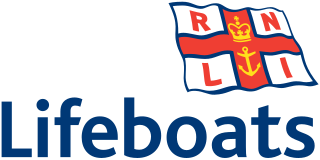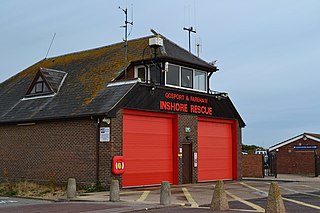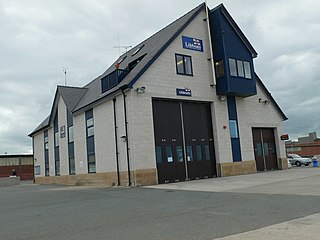
The Royal National Lifeboat Institution (RNLI) is the largest of the lifeboat services operating around the coasts of the United Kingdom, the Republic of Ireland, the Channel Islands, and the Isle of Man, as well as on some inland waterways.

Inflatable Rescue Boats (IRBs) are rubber boats with an outboard motor used in surf lifesaving. IRBs have been used for all forms of surf rescue, retrieval, and service by Surf Lifesaving in New Zealand, Australia, and Del Mar, California since the late 1980s.

The D-class (EA16) lifeboat is a class of inflatable boat operated since 1987 by the Royal National Lifeboat Institution of the United Kingdom and Ireland. It has been replaced operationally by the D-class (IB1), but many are still used as part of the relief fleet, as boarding boats for the larger classes of lifeboat and by the RNLI Flood Rescue Team.

The D-class (IB1) lifeboats are inflatable boats serving in the RNLI inshore lifeboat (ILB) fleet as well as a number of Independent Lifeboats around the UK and Ireland. Although they are known as the "IB1" at times, they are the latest development of the D-class lifeboat and as such are mainly referred to as a "D-class".
Since its inception, the Royal National Lifeboat Institution (RNLI) has provided lifeboats to lifeboat stations in the United Kingdom and Ireland.
Blyth Lifeboat Station is operated by the Royal National Lifeboat Institution and currently operates a D-class (IB1) Sally Forth (D-878) and a B-class lifeboat Patricia Southall (B-923)
A rescue lifeboat is a boat rescue craft which is used to attend a vessel in distress, or its survivors, to rescue crew and passengers. It can be hand pulled, sail powered or powered by an engine. Lifeboats may be rigid, inflatable or rigid-inflatable combination-hulled vessels.

Atlantic College Lifeboat Station was an inshore lifeboat station based at the United World College of the Atlantic on the coast of South Wales, responsible for rescues in the challenging waters of the Bristol Channel.

Porthcawl Lifeboat Station opened in 1860 and a boathouse was subsequently built on the promenade to house the lifeboat. This station was closed in 1902 when Porthcawl Dock was closed.

Gosport Lifeboat Station is a volunteer-operated independent lifeboat station charity located in the village of Alverstoke on the peninsula of Gosport in the English county of Hampshire. Owned and operated by Gosport and Fareham Inshore Rescue Service (GAFIRS), it operates free lifeboat services in the Solent from Portsmouth Harbour to Titchfield Haven, on the approaching shores of Southampton Water. GAFIRS is a charity registered in England and Wales (1159681).

Ilfracombe Lifeboat Station is the base for Royal National Lifeboat Institution (RNLI) search and rescue operations at Ilfracombe, Devon, England. The first lifeboat was stationed in the town in 1828 and the present station was opened in 1996. For 29 years a second boat was operated from Morte Bay at Woolacombe.

Burnham Area Rescue Boat (BARB), also known as BARB Search & Rescue, is a voluntary independent search and rescue service, formed in 1992 in Burnham-on-Sea, Somerset that operates two rescue hovercraft and two inshore rescue boats in the Bridgwater Bay area. It is a registered charity.

Rhyl Lifeboat Station is operated by the Royal National Lifeboat Institution (RNLI) in the North Wales town of Rhyl. For over 150 years, the Lifeboat Crew in Rhyl have been saving lives at sea. The first lifeboat was stationed in the town in 1852 and the present station was opened in December 2001. The station operates a Shannon-class All-weather lifeboat (ALB), and an D-class (IB1) Inshore lifeboat (ILB).

Cardigan Lifeboat Station, at Poppit Sands, North Pembrokeshire, near Cardigan, Ceredigion, Wales, is a Royal National Lifeboat Institution (RNLI) lifeboat station opened in 1849. The station closed in 1932 but reopened in 1971 as an inshore lifeboat station.

Hayling Island Lifeboat Station is a Royal National Lifeboat Institution station located on Hayling Island in the English county of Hampshire, on the eastern side of the island at the entrance to Chichester Harbour where it joins the major shipping route of the Solent, and is opposite the village of West Wittering. This major shipping route is busy at all times of the year and there are estimated to be 10,000 boats in the Chichester area alone. The Hayling Island station provides cover for the area 24 hours a day, all year, by means of two inshore rigid inflatable lifeboats placed on this station.

Happisburgh Lifeboat Station is a Royal National Lifeboat Institution (RNLI) Inshore lifeboat station close to the village of Happisburgh in the English county of Norfolk in the United Kingdom. Since 2003 the station boathouse has been re-located from the village to an area south called Cart Gap. This is because the beach below Happisburgh disappeared due to coastal erosion and the stations slipway and access was washed away. The original boathouse in the village is now used for training.

Eastbourne Lifeboat Station is a Royal National Lifeboat Institution (RNLI) lifeboat station in the town of Eastbourne in East Sussex. Founded two years before the RNLI was established, the station has operated continuously since 1822 and its lifeboats have been responsible for saving over 700 lives. There are two active lifeboat stations in Eastbourne, an all-weather station with the Trent-class 14-02 Esme Anderson at Sovereign Harbour and the D-class (IB1) The David H (D-876) at the inshore lifeboat station a couple of miles to the west at Fisherman's Green. An older lifeboat station, west of Eastbourne Pier, is now used as an RNLI museum.

Aberystwyth Lifeboat Station is a Royal National Lifeboat Institution (RNLI) lifeboat station in the coastal resort of Aberystwyth, Ceredigion, West Wales. It was established in 1861, but there has been a lifeboat serving the town since 1843.
The D-class lifeboat was a sub-class of 4 inflatable boats operated as part of the D-class between 1971 and 1986 by the Royal National Lifeboat Institution of the United Kingdom and Ireland. It was superseded by the D-class lifeboat.

Barmouth Lifeboat Station is located in Barmouth, a town at the mouth of the Afon Mawddach river in Gwynedd, Wales. A lifeboat was first stationed here by the Royal National Institute for the Preservation of Life from Shipwreck (RNIPLS) in 1828.
















